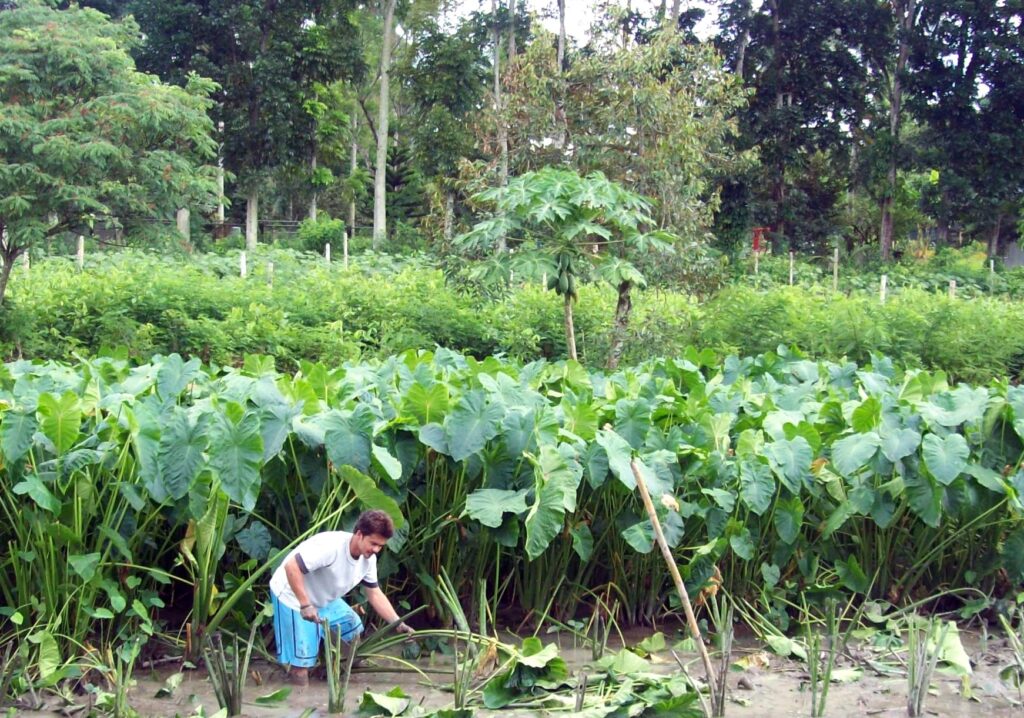Text and Photos by Henrylito D. Tacio
Taro – or gabi as it is called by Filipinos — was once one of the most edible root crops in the world because it is loaded with essential nutrients and vitamins. In the Philippines, this starchy tuber has faded from the grocery list of modern consumers, who are unaware of the healthy benefits of the crop.
The word taro was taken from Tahitian or other Polynesian languages. Its scientific name is Colocasia esculenta; esculent is an English word taken directly from Latin and it means “edible.” Taro’s corm or underground stems as well as leaves or petioles are edible.
Taro’s boiled corm and cooked petioles provide numerous health benefits. This is because taro is a good source of dietary fiber, vitamins B, C, and E, iron, calcium, copper, phosphorus, potassium, magnesium, thiamine, riboflavin, and zinc. It has low content of saturated fat, cholesterol and sodium. Taro corms are very high in starch, and are a good source of dietary fiber.
Calcium oxalate is reportedly present in raw taro leaves which is poisonous, according to Alan Davidson in the Oxford Companion to Food. There was this story of a business class passenger on a transpacific flight of a major airline who fell mysteriously ill. An investigation discovered that a meal served on board was presented on top of a raw cut taro leaf used as the garnish.
Despite this, the leaves are completely safe and delicious after cooking. Also, extra care must be taken to oil your hands before handling the leaves, as some leaves are acidic and cause scratching. Generally, the leaves are often dried in the sun first before cooking.
The gabi leaves are very popular in Asian dishes. In the Philippines, for instance, taro stems and petioles are the main ingredients of laing that is cooked in coconut milk, salted with fermented shrimp and spiced with red hot chillies, particularly siling labuyo. In India, the leaves are rolled along with gram flour batter and then fried or steamed to make a dish called patode which is finished by tempering with red chillies.
In the past, taro has been prescribed in the past as effective in combating malnutrition and indigestion. It was also known as an effective treatment to ulcers, eczema, diarrhea, asthma and bronchial ailments. Its stem is applied topically to heal burns, boils, skin rashes, insect bites, and even wounds.
Aside from being a main source of nutrients, taro is used as herbal medicine. The juice of its petioles is used for earache and internal hemorrhages. On the other hand, the juice of its corm is a good laxative and acts as an antidote for wasp and insect stings. Heated, the gabi corm can ease painful rheumatic joints.
Taro is planted primarily for its corm. Ginataan, a popular Filipino dessert, uses coconut milk and gabi that are mixed with tropical fruits. In India, it is used as a staple food, as a side dish, or as a component in various side dishes. As a staple food it is steamed, and eaten with a chutney of green pepper and shallot onions.
In China, taro is mainly used as a flavor enhancing ingredient. It is commonly braised with pork or beef. It is used in the dim sum cuisine of the southern part of the country to make a small plated dish called taro dumpling, as well as a pan-fried dish called taro cake. It is also woven to form a seafood birdsnest. The taro cake is also a delicacy traditionally eaten during the Chinese New Year. In desserts, it is used in tong sui, bubble tea, as a flavoring in ice cream and other desserts.
In Taiwan, taro chips are often used as a potato-chip-like snack. Compared to potato chips, gabi chips are harder and have a more assertive nutty flavor. They are generally made from upland taro because of their lower moisture.
In Japan, taro was a regional staple food before rice became predominant. The corm is often prepared through simmering, but occasionally grated and eaten raw or steamed. In Bangladesh, taro is cooked with small prawn into thick curry.
Flour can also be produced from taro corms. The flour can be used for soups, biscuits, bread, beverages, and puddings. Taro starch is highly digestible and is recommended as baby food. In Hawaii, chemical studies to determine the food properties of poi (a native food prepared from boiled taro corms mixed with water, cooked, mashed into paste, and slightly fermented) have confirmed its value as food for normal, allergic and potentially allergic babies.
Taro is native to the Old World, but has become an important crop in the equatorial regions of the world. It is believed to have been cultivated as long as 6000 years ago and some sources assert that it originated in Southeast Asia or India.
In the Philippines, taro can be grown anywhere as it grows on all kinds of soils. But for best results, it must be planted on deep, well-drained, friable loams, particularly alluvial loams with a high level of water table. Saline soils could be tolerated by taro.
“The crop can be grown in all parts of the Philippines, from sea level to 1,800 meters high,” notes The Philippines Recommends for Gabi, published by the Philippine Council for Agriculture, Forestry, and Natural Resources Research and Development (PCARRD). “The crop has particular potential in marshy, waterlogged regions and for coastal and saline areas.” — ###




